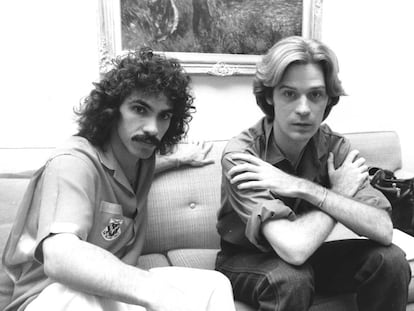World Press Photo excludes Photo of the Year from cover due to its ‘explicit’ content
The foundation justified its decision by saying that the image chosen for the cover is more appropriate for a book ‘that is sold in museums and bookstores’

The cover of the 2023 Yearbook by the World Press Photo Contest does not show the image that won the Photo of the Year award, as is usually the case. The winning photo — taken by Ukrainian photographer Evgeniy Maloletka for the Associated Press — shows Irina Kalinina, a 32-year-old pregnant woman who was injured in a Russian bombing on a hospital, being taken away on a stretcher. The image was taken on March 9, 2022, in the Ukrainian city of Mariupol. Irina’s baby was stillborn, and she died half an hour later.
The World Press Photo Contest, however, has decided not to publish the image on the cover of the 2023 Yearbook. “It was more appropriate to use another photo for the cover because it is a book that will be displayed in museum gift shops and bookstores,” Joumana El Zein Khoury, the executive director of the World Press Photo Foundation, told EL PAÍS by email.
For the cover, the World Press Photo Contest chose instead an image by Iranian photographer Ahmad Halabisaz, which received an honorable mention. This photo portrays a young woman in a square in Tehran, dressed in Western clothing in defiance of Iranian law. The shot was taken by Halabisaz on December 27, 2022.
El Zein Khoury says that both photos “document the injustice” and “the risks faced by the authors and their subjects.” “Maloletka’s work is absolutely important and that is why she was awarded and figures prominently in the 2023 exhibition that tours the world,” across 70 cities in 30 countries. The World Press Photo Contest justified its decision not to include Maloletka’s photo on the cover on its website: “This is a conscious stance to show our respect towards the victims and our rage against the inhuman loss of lives.”
The only criterion for the cover, says El Zein Khoury, is “to make the images known in an accessible way to a broad and international public.”
This is not the first time that the contest has decided not to publish the Photo of the Year on the cover of its yearbook. “The decision made is part of a broader change that has been taking place in the last five years, which is not to use explicit images for commercial purposes or in promotion. Others that have less explicit violent content are also chosen for the posters that announce the exhibition in the cities,” Marika Cukrowski, the World Press Photo curator, told EL PAÍS. “The decision, taken jointly by the jury and the organization, was decided very soon, almost immediately after the winner was chosen.” She said that both photographers “understood and agreed” on the ruling.

The main person affected by the decision is Maloletka. “I saw the cover of the book with the other image when I received the award. Ahmad’s photo has no sensitive information [in the sense that it might hurt sensitivities], unlike mine. That’s probably why this decision was made,” she told EL PAÍS by email. For her, her image of Irina sparked a debate and explained “what Russia was doing, destroying Ukrainian cities with no regard for casualties, even if they were children.” The photo also illustrated “a fact that Russia tried to hide and could not, and that Russian propaganda tried to discredit journalists with false accusations.”
Halabisaz, for her part, explains that today’s photojournalism “is not just about war, blood and natural disasters.” In an email, she explained that her photo “sheds light on the tireless efforts of Iranian women fighting for their rights in the 21st century.” She took the shot “in one minute, at risk and without permission.” Halabisaz says she spent “27 days in prison” for covering the protests in Tehran.
The Spanish photojournalist Santi Palacios, who won second prize at the 2017 World Press Photo, disagrees with the organization’s decision. “It is one more sign of what is happening. The fact there is so much concern about not showing explicit images ends up disguising the world seen from photojournalism. Furthermore, the winning image was already seen everywhere.” Palacios points out that “more and more explicit images are seen on social media, while limitations are placed on the professional [photographer]. When what you have to do is protect them.”
Palacios was also a member of the jury for the European region of this year’s World Press Photo Contest. The awards are divided into four categories: Singles, Stories, Long-Term Projects and Open Format. The juries from the six worldwide regions — Africa, Asia, Europe, North and Central America, South America, and Southeast Asia and Oceania — chose the best images from their section. The final jury, which selects the winners, is made up of one member from each of the regional committees and a global president.
“Behind the decisions there is good intention and a lot of work to find balances between the different aspects,” said Palacios. When asked how would he have reacted if his photo was not allowed on the cover, he said: “It would make me angry, even though the jury’s decision may be justified.”
Sandra Balsells, another award-winning photojournalist, told EL PAÍS that the winning photo “shows the carnage of that war against civilians, but it is respectful.” She wonders “if the same decision would have been made if Irina had survived.” Balsells added: “It’s strange that if you’ve been brave enough to support a photo, that you then make it invisible by not giving it the cover of the catalog.”

Other years that the winning photo was not on the cover
This is not the first time that the World Press Photo Contest has not used the Photo of the Year for the cover of its yearbook. In 1974, it opted not to use the winning image by Orlando Lagos, which showed Chilean president Salvador Allende being forcibly led out of La Moneda presidential palace during the military coup.
Nor did the organization publish on the cover the 1983 winner by U.S. photographer Robin Moyer, which depicted the Palestinian victims of the Sabra and Shatila massacre during the Lebanese Civil War.
And in 1993, it also chose a different image for the cover. The winning image that year was by American photographer James Nachtwey and showed a Somali woman carrying her starving son in her arms to a mass grave.
Sign up for our weekly newsletter to get more English-language news coverage from EL PAÍS USA Edition
Tu suscripción se está usando en otro dispositivo
¿Quieres añadir otro usuario a tu suscripción?
Si continúas leyendo en este dispositivo, no se podrá leer en el otro.
FlechaTu suscripción se está usando en otro dispositivo y solo puedes acceder a EL PAÍS desde un dispositivo a la vez.
Si quieres compartir tu cuenta, cambia tu suscripción a la modalidad Premium, así podrás añadir otro usuario. Cada uno accederá con su propia cuenta de email, lo que os permitirá personalizar vuestra experiencia en EL PAÍS.
¿Tienes una suscripción de empresa? Accede aquí para contratar más cuentas.
En el caso de no saber quién está usando tu cuenta, te recomendamos cambiar tu contraseña aquí.
Si decides continuar compartiendo tu cuenta, este mensaje se mostrará en tu dispositivo y en el de la otra persona que está usando tu cuenta de forma indefinida, afectando a tu experiencia de lectura. Puedes consultar aquí los términos y condiciones de la suscripción digital.
More information
Archived In
Últimas noticias
Welcome to the post-religion era: The idea of Christianity as the absolute truth has become obsolete
‘I thought you would like it’: The risky sexual practice popularized by TV shows and TikTok
The digitalization of tourism: ‘They promise experiences and gave us the worst possible one’
Mexican peso defies uncertainty with forecasts of a new period of stability in 2026
Most viewed
- Sinaloa Cartel war is taking its toll on Los Chapitos
- Oona Chaplin: ‘I told James Cameron that I was living in a treehouse and starting a permaculture project with a friend’
- Reinhard Genzel, Nobel laureate in physics: ‘One-minute videos will never give you the truth’
- Why the price of coffee has skyrocketed: from Brazilian plantations to specialty coffee houses
- Silver prices are going crazy: This is what’s fueling the rally










































